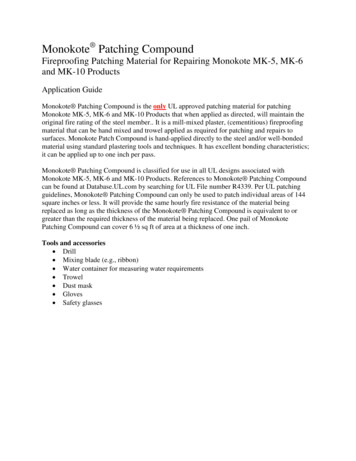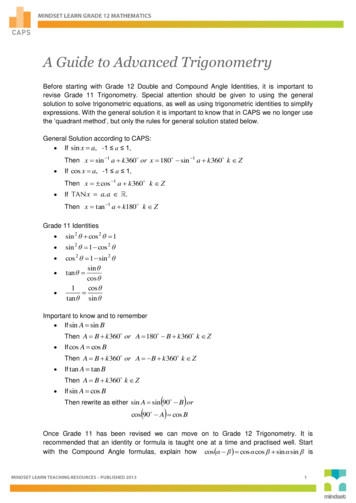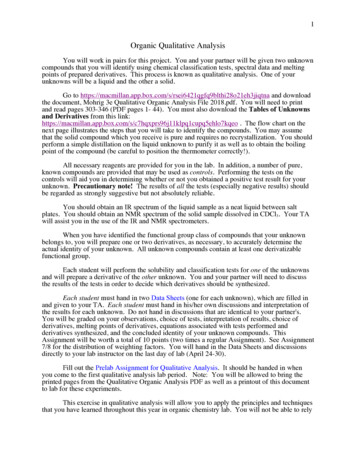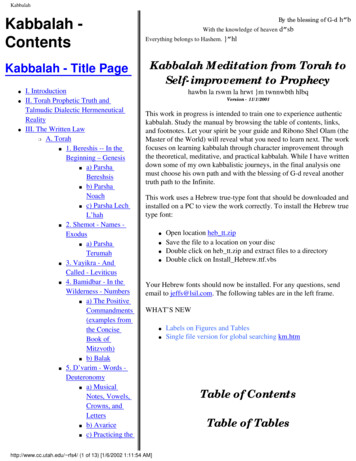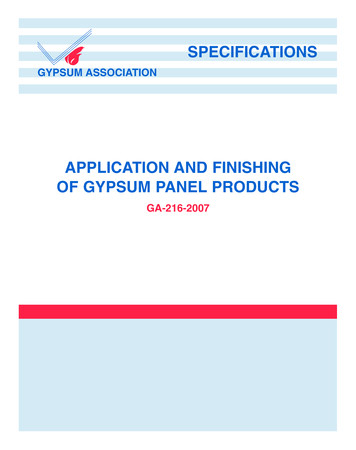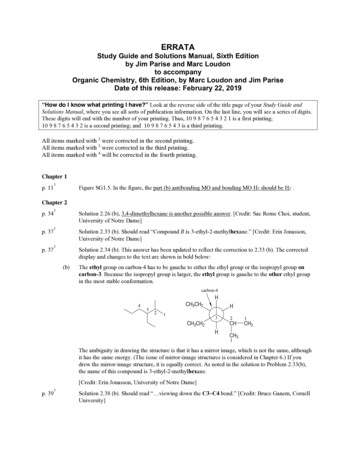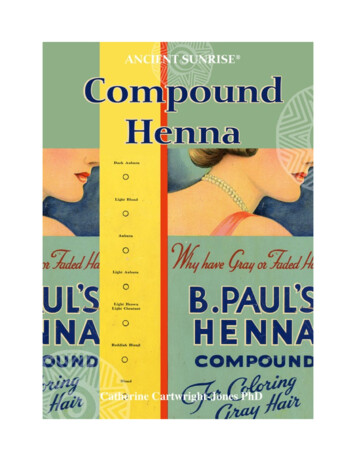
Transcription
Compound henna: Part 1Henna, lawsonia inermis, has ONE translucent dye color, rusty red-orange, based on the lawsonemolecule precursors naturally produced in the henna leaf. The commercially available hennahair dyes that come in “colors,” such as black, brunette, chestnut, blonde, and so on, arecompound hennas. These products have additives to change the color of henna. The additivesmay be other plants, toxic metallic salts, chemical dyes, ingredients that have quasi-spiritualclaims, and para-phenylenediamine to create a range of colors. These hair dyes often containlittle henna, or possibly even no henna whatsoever. Sometimes these compound henna dyeadditives are harmless, others are dangerous. If the additives and adulterants are not declared,they can cause all sorts of health problems as well as destructive cross-reactions if they come incontact with the chemicals used in oxidative dyes.The added ingredients in compound hennas are often not listed or the declarations may befallacious if the countries of origin do not require declarations for cosmetics, or if themanufacturer chooses to obfuscate for profit. If exported to the west; there is no requirement thatthe additives be discovered and declared. The pre-packaged henna compounds are often termed“natural herbal henna.” This is misleading as these are not “natural” products; they are full ofsynthetic chemicals. Metallic salts alter and fix color in lieu of higher quality henna. Thecompounds of henna and metallic salts can react disastrously with synthetic hair dye, seriouslydamaging hair. The most frequently used material is lead acetate, though silver nitrate, copper,nickel, cobalt, bismuth and iron salts have also been used. Dyes with lead acetate graduallydeposit a mixture of lead sulfide and lead oxide on the hair shaft. When you hear that henna has“metal,” “lead,” or “coats the hair,” and “leaves it brittle,” a compound henna dye is beingreferred to, not pure body art quality henna1 such as Ancient Sunrise .Compound henna advertising “Pure Herbal Henna” containing PPD (para-phenylenediamine),and 2 Nitro (2-nitro-p-phenylenediamine), hazardous oxidative coal tar dyes.1In 1999, Catherine Cartwright-Jones first termed “body art quality henna” on hennapage.com to refer to henna thatwas free from additives, contaminants, and adulterants. The henna industry since has taken up the use of “body artquality henna” to differentiate compound henna from pure henna.“Ancient Sunrise Henna for Hair” Chapter 3, part 1, Copyright 2018, Catherine Cartwright-Jones PhD, TapDancing Lizard LLC www.mehandi.com www.hennaforhair.com www.ancientsunrise.com
A Historical Perspective of Compound henna: Henna hair dye in United Kingdom andFrench marketplace in the nineteenth centuryFrederick Sandys – ‘Proud Maisie’ also known as 'Love's Shadow,’ 1860-68Henna was an exotic import entering the European market through the trade pathways of NorthAfrica and the Ottoman Empire to England, France, and Italy in the 19th century. The PreRaphaelite Brotherhood painters2 were fascinated with the color range and reflectiveness ofhenna. Frederick Sandys painted Proud Maisie with shimmering hennaed hair. John WilliamWaterhouse, Dante Gabriel Rosetti, John Everett Millais, and Sir Edward Burne-Jones paintedwomen whose hair was henna-consistent tones of strawberry blonde, vivid red, and auburn.They often mixed Orientalist elements into their paintings, having an interest in other aspects ofPersian, Ottoman, Arab, and North African culture.2Founded in 1848 by Dante Gabriel Rossetti, William Holman Hunt, and John Everett Millais, later includingWilliam Michael Rossetti, James Collinson, Frederic George Stephens, and Thomas Woolner.“Ancient Sunrise Henna for Hair” Chapter 3, part 1, Copyright 2018, Catherine Cartwright-Jones PhD, TapDancing Lizard LLC www.mehandi.com www.hennaforhair.com www.ancientsunrise.com
William Holman Hunt, self-portrait, 1875, Uffizi Gallery, Florence, ItalyWilliam Holman Hunt, one of the founders of the post Pre-Raphaelite Brotherhood, appears tohave also hennaed his beard for this self-portrait, and taken a keen interest in men’s Orientalgarments following his trip to the Holy Land in the mid 1850’s. His self-portrait at age 17, from1845,3 shows that he had unremarkable light brunette hair. A portrait in 1900 as an old manshows his light brunette hair again, with a white beard.4Even without formulas and import records, these paintings demonstrate a popular culture risingenthusiasm for henna in the mid-19th century in the United Kingdom. The poem, “Lalla Rookh,”indicates that henna and its cultural context had been in popular English awareness at least a fewdecades earlier.“While some bring leaves of henna, to imbueThe fingers’ ends with a bright roseate hue,So bright, that in the mirror’s death they seemLike tips of coral branches in the stream;And others mix the Kohol’s jetty dyeTo give that long, dark languish to the eyeWhich makes the maids, whom kings are proud to cullFrom fair Circassia’s vales, so beautiful.”From “Lalla Rookh,” 1817, by Thomas Moore 53William Holman Hunt, self-portrait, 1845, Birmingham Museum and Art Gallery, Birmingham, UKWilliam Holman Hunt by Sir William Blake Richmond, 1900, National Portrait Gallery, London. NPG 28035Moore, T. Lalla Rookh, an Oriental Romance, Thomas Y Crowell & Co. New York 1884, p. 52Note on “The fingers’ ends with a bright roseate hue, “They tinged the ends of their fingers scarlet withhenna, so that they resembled the branches of coral.” – Story of Prince Futtun in Bahardanush4“Ancient Sunrise Henna for Hair” Chapter 3, part 1, Copyright 2018, Catherine Cartwright-Jones PhD, TapDancing Lizard LLC www.mehandi.com www.hennaforhair.com www.ancientsunrise.com
Henri de Toulouse-Lautrec, Rousse, La Toilette, 18896In Paris in the 1890’s, Henri de Toulouse-Lautrec painted women of the Moulin Rouge, favoritecafes and brothels who adopted the fashion of hennaed hair. In a number of studies, hedocumented the range and luminosity of hennaed hair, from golden yellow to auburn,particularly in the way it caught sunlight and stage lighting. Judging by the sketches, lithographs,and paintings of Paris popular culture during the Fin de siècle, pure henna was widely used, safe,and very fashionable.Hair dyeing during the Belle Époque was considered vaguely naughty. 7 Some of this sense ofimpropriety may have been ‘tut-tutting’ caused by the dangerousness of hair dyes other thanhenna. Hair dye chemistry was rudimentary, experimental, based on textile dyes, and oftenhazardous. The actress, Caroline Otero, was seriously burned in 1909 when several drops of the6Henri de Toulouse-Lautrec, Rousse (La toilette) 1889, Musée d'Orsay, Paris, Bequest of Pierre Goujon 1914Zdatny, S, ed. (1999) Hairstyles and Fashion, a Hairdresser’s History of Paris, 1910 – 1920, Berg, Oxford, UK,p. 177“Ancient Sunrise Henna for Hair” Chapter 3, part 1, Copyright 2018, Catherine Cartwright-Jones PhD, TapDancing Lizard LLC www.mehandi.com www.hennaforhair.com www.ancientsunrise.com
lotion she was pouring on her head came in contact with a water heater.8 The public prosecutorof the Seine Department registered 142 complaints relating to hair-coloring torts in 1902, and thefear of burns, rashes and hair loss was endemic.9 In 1915, “Bulgarian colors” had a rush ofpopularity: blue, green, and mauve colored hair, probably coal tar derived lake dyes.10 The risk tothe dyer was as great as to the client, but the increased and reliable revenue from the monthlyupkeep was attractive enough for salons to commit to the practice.Brothel workers with hennaed hair by Henri de Toulouse-Lautrec, Salon de la rue des Moulins,1894 – 5, Musée Toulouse-Lautrec, Albi, France8Journal de la Coiffure, February 1904La Coiffure de Paris, October-November 1909, p. 1410Zdatny, S, ed. (1999) Hairstyles and Fashion, a Hairdresser’s History of Paris, 1910 – 1920, Berg, Oxford, UK,p. 17, from HWJS, April 19159“Ancient Sunrise Henna for Hair” Chapter 3, part 1, Copyright 2018, Catherine Cartwright-Jones PhD, TapDancing Lizard LLC www.mehandi.com www.hennaforhair.com www.ancientsunrise.com
Historical Perspective of Compound henna: Rasticks, Liquid Rasticks, Henna-Reng, andHenna-RastiksCircassian Hair Dye, copyright 1843, Library of Congress USA. The product description anddate is consistent with the export of rasticks as hair dye19th century London chemist and perfumer Septimus Piesse reported on Armenians inConstantinople formulating cosmetics, specifically a black hair dye based on rasticks.11 InArmenia, pyrites, (FeS₂), were mined for rastik powdered cosmetic compounds and usedthroughout Persia for darkening eyebrows and moustaches. M. Landerer described theformulation of this black hair dye: pulverized galls were kneaded with oil to make a paste, heated11"Turkish Hair Dye" Scientific American 18, no. 19 (1868): 296.“Ancient Sunrise Henna for Hair” Chapter 3, part 1, Copyright 2018, Catherine Cartwright-Jones PhD, TapDancing Lizard LLC www.mehandi.com www.hennaforhair.com www.ancientsunrise.com
in an iron pan until the oil vapors were released. The residue was then titrated with water into apaste, and heated to dryness again. A metallic mixture from Egypt called Rastikopetra, or RastikYuzi, powdered fused iron and copper, was mixed into a moistened gall mass, and a perfumeadded. The word “rastik” meant eyebrows, and “yuzi” meant stone, thus the name Rastik-Yuzi,eyebrow stone, was a cosmetic to blacken eyebrows. This compound metal mixed with gallpowder was rubbed into hair and beards to blacken them, or mixed into henna to dye the hair.The proportions of the Turkish rastick beard dye were specified by Redgrove:12Powdered galls: 2000 partsIron filings: 50 partsCopper filings: 2 partsMusk: 2 partsThis was applied as a pack in hair and left for several hours, then washed out. The pyrogallol onthe surface of the hair rapidly oxidized to a dark brown color. This rastick left the hair dulllooking and copper often causes contact dermatitis. When mixed with henna, the rastick metalcompound was less damaging to hair.Rastick from Persia, HENNA PERSIAN for eyebrows, eyelids, and moustaches” early 20thcentury, by GABMAR & Co. Ispahan (sic) Persia. The glass vial of rastik is about 1” long.1312Redgrove, H. S., Foan, G. A., Woolss, J. B., (1939). Hair-Dyes and Hair-Dyeing Chemistry and Technique. Anew edition completely revised by H.S. Redgrove and J. Bari-Woollss, etc. William Heinemann. (Medical BooksLTD. London p. 48 – 4913Collection of Catherine Cartwright-Jones PhD“Ancient Sunrise Henna for Hair” Chapter 3, part 1, Copyright 2018, Catherine Cartwright-Jones PhD, TapDancing Lizard LLC www.mehandi.com www.hennaforhair.com www.ancientsunrise.com
Rastick from Persia, “HENNA PERSIAN for eyebrows, eyelids, and moustaches” packaginginsert sheet. GABMAR & Co. Ispahan (sic) Persia, early 20th centuryLiquid RasticksLiquid rasticks were developed and patented in France by Schueller in 1907, (French Patent No.383,920) based on a method of using a reduction agent in combination with pyrogallol solutionsand metallic salts. The darkening reaction between pyrogallol and the metallic salt was kept incheck by an oxidizing agent such as sodium sulphite until the liquid was applied to the hair. Theliquid rastik on the hair surface darkened through a reaction with atmospheric oxygen.14 Theseliquid rastick dyes were the basis of progressive dyes, the hair dyeing solutions of metallic salts.The most commonly used metallic salts for liquid rasticks and progressive dyes were and aresalts of lead, bismuth, antimony, iron. These hair dyes were and are still potentially toxic, andcan have violent chemical cross reactions with perming and oxidative dyes.Two commercial brunette hair dye versions of rastick based on pyrogallol and copper werepublished based on the analyses of proprietary hair dyes by the British Medical Association15 in1912. “Under suitable circumstances, pyrogallol will combine with strong sulphuric acid toproduce pyrogallol-sulphonic acid. Accoding to a German invention, the alkaline salts of thissubstance are suitable for hair dyeing and are said to be less poisonous than pyrogallol itself.1614Ibid p. 49More Secret Remedies: what they Cost and What they contain, Based on Analyses made for the British MedicalAssociation. London, 1912,16Redgrove, H. S., Foan, G. A., Woolss, J. B., (1939) Hair-Dyes and Hair-Dyeing Chemistry and Technique. A newedition completely revised by H.S. Redgrove and J. Bari-Woollss, etc. William Heinemann. (Medical Books LTD.London, p. 5015“Ancient Sunrise Henna for Hair” Chapter 3, part 1, Copyright 2018, Catherine Cartwright-Jones PhD, TapDancing Lizard LLC www.mehandi.com www.hennaforhair.com www.ancientsunrise.com
PyrogallolCopper Chloride (anhydrous)Hydrochloric acid (B.P.strength)Sulphuric AcidWaterNo. 13.8 parts1.8 parts0.75 parts0.07 partsTo 100 partsNo 2.2.1 parts1.3 parts0.3 partsnilTo 100 partsCurrent men’s progressive hair dye products are based on a solution containing lead acetate thatis applied daily, to gradually, “progressively” dye the exterior of the hair dark as the salts toabsorb oxygen from the air. This daily application and oxidation gradually colors gray hairdarker. These dyes was advertised as a way to “blend away the gray” for men who wanted a“touch of gray” for the social advantage of maturity without actually appearing elderly, and amore natural appearance with a less abrupt hair color change than would occur with oxidativedye. Men could be spared the embarrassment of people noticing that they were dyeing their hair.Metallic, or progressive dyes, are avoided in salon practice as they have adverse chemicalreactions with oxidative dyes, permanent curling solutions, and hair relaxers.This postcard, published around 1920, shows a liquid hair dye being used to darken hair, as wasdone with liquid rasticks composed of iron, copper, pyrogallol, hydrochloric acid and sulphuricacid.1717From image collection of Catherine Cartwright-Jones PhD“Ancient Sunrise Henna for Hair” Chapter 3, part 1, Copyright 2018, Catherine Cartwright-Jones PhD, TapDancing Lizard LLC www.mehandi.com www.hennaforhair.com www.ancientsunrise.com
Henna-RengIn Persia and other countries, partially fermented indigo was applied with henna to createbrunette and black hair dyes. The resulting colors were stable, reliable, and convenientlymatched the range of human hair color. The henna-reng dyes were, and are, very safe andbeneficial for hair. Redgrove notes that in a warm country where indigo is produced and there isa source of live henna vat readily available, dying ones hair with henna and indigo is easy,harmless, and results are reliable.18 When the fermented indigo had to be dried, powdered, andexported long distances, the indoxyls were vulnerable to damp and cold, so that when theproduct traveled from Persia to England, stylists often got inexplicably poor results. Thesynthetic indigo developed by Adolph von Baeyer in 1878 and perfected in 1897, was unsuitablefor hair dye, as the sequence of precursor and intermediate dye molecules are not available todye hair as described in “Ancient Sunrise Chapter 5, Plants that Dye Hair.”19Empty cloth bags of Iranian partially fermented indigo (vashma) for henna-reng hair dyeVashma, partially fermented indigo was exported from Iran in cloth bags to the USA for hennareng. This packaging was vulnerable to air, freezing, and dampness, so that the intermediateindoxyl dye molecules were prone to oxidation to the inert pigment indigo. Until air freight,light-proof and waterproof packaging became available towards the end of the twentieth century,henna-reng was unreliable.For more reliable results than provided by damaged henna-reng, G. Rozier in Formulaire deParfumerie recommended brunette mixtures with 5 in 1000 parts of potassium dichromate be18Redgrove, H. S., Foan, G. A., Woolss, J. B., (1939) Hair-Dyes and Hair-Dyeing Chemistry and Technique. A newedition completely revised by H.S. Redgrove and J. Bari-Woollss, etc. William Heinemann. (Medical Books LTD.London, p. 7719Ancient Sunrise Chapter 5, Plants that Dye Hairhttp://www.tapdancinglizard.com/AS henna for hair/chapters/chap5/5 Indigo Indigofera Tinctoria.pdf“Ancient Sunrise Henna for Hair” Chapter 3, part 1, Copyright 2018, Catherine Cartwright-Jones PhD, TapDancing Lizard LLC www.mehandi.com www.hennaforhair.com www.ancientsunrise.com
added as an oxidizing agent to equal parts of henna and indigo for dark chestnut color, and threeparts henna and seven parts indigo for black. Redgrove discouraged the addition of potassiumdichromate to henna-reng because it was poisonous.20 Redgrove proposed Gastou’s formula forhenna rastik as safer: 30g of ferrous sulphate, 30 grams of powdered galls, and 60 grams ofhenna, mixed with warm water, and applied in the hair as a pack for two hours, then washedout.21Even when packaging and export problems were solved, the knowledge of henna-reng (hennaindigo) technique chemistry seems to have been fractured and forgotten over several decades ofdisuse. The understanding that henna and indigo require different pH environments to producethe dye intermediate, and produce them at different speeds was ignored by the hair dye industryso that producers mixed henna and indigo powder together, giving consumers poor results in premixed, boxed henna.Henna-RasticksWhen vashma indigo was unavailable or the precursor-intermediate dye chemistry of naturalindigo was misunderstood, henna was formulated to produce brunette and black colors bycombining henna with rastick dyes to create the wide range of compound henna shades. Manyclients wanted to erase the appearance of aging by matching their gray to their natural color andonly 2% of the population naturally has red hair. Henna by itself was seen as limiting, as red hairwas often culturally distained.Table for Henna-Rastik Compound Henna Formulation22Henna powderPyrogallolCopper SulphateSiennaLampblackLight Brown100555nilBrown1004752Dark Brown100108105Black10015101020The purpose of the sienna (an earth pigment containing iron oxide and manganese oxide) andlampblack (charred organic materials such as wood or bone) were to make the powder appearsimilar to the color of the expected dye results. Neither earth pigment nor char actually dyed thehair.20Redgrove, H. S., Foan, G. A., Woolss, J. B., (1939). Hair-Dyes and Hair-Dyeing Chemistry and Technique. A newedition completely revised by H.S. Redgrove and J. Bari-Woollss, etc. William Heinemann. (Medical Books LTD.London p. 7821Gastou, Dr. Paul. (1923) Formulaire cosmetique et esthique Second Edition, Paris.22Redgrove, H. S., Foan, G. A., Woolss, J. B., (1939). Hair-Dyes and Hair-Dyeing Chemistry and Technique. Anew edition completely revised by H.S. Redgrove and J. Bari-Woollss, etc. William Heinemann. (Medical BooksLTD. London p.79“Ancient Sunrise Henna for Hair” Chapter 3, part 1, Copyright 2018, Catherine Cartwright-Jones PhD, TapDancing Lizard LLC www.mehandi.com www.hennaforhair.com www.ancientsunrise.com
Postcard of hair dye, early 20th century.Scientists and physicians debated the dangerousness of copper and pyrogallol in henna-rasticks.Henna was harmless but took time to prepare and apply. Safety took second place to consumerdemand and profitability. Oscar Levin MD was particularly damning of pyrogallol and copper.23He noted that the presentation of copper poisoning from hair dye was similar to that of workersfrom copper refineries whose hair turned greenish black from long exposure.“The toxic effects of copper (Industrial poisoning) are not felt only by factory workers,however. The society matron who turns enthusiastically to “a wonderful dye” thatsomebody or other recommends to her shows exactly the same effects, when the dye isone of the copper sulphate preparations.Levin continues to describe a typical case of dermatitis from exposure to copper. The subject hadbeen using a copper henna-rastick every other month for three years. The dermatitis developedafter extended exposure, progressing to a swollen and oozing scalp. Her hair was dyed black, butwas damaged and brittle. He also reported evidence of hair dye causing lead poisoning from leadsulphide in compound henna hair dye, antimony poisoning, bismuth, tin, and cobalt poisoning.He stated that iron was less harmful in compound henna, but was infrequently used as a dyebecause the color faded. When iron was used in conjunction with cyanide in hair dye, it wasmore effective as a colorant, but poisonous. 24 Levin regarded all of the henna compounds andhenna-rastiks as potentially harmful to health. He unequivocally recommended pure henna ashair dye. Schuller regarded henna-rastiks as safe if the pyrogallol and metallic salts were lessthan 10% of the total weight.2523“Shall I Dye My Hair? The Question that Woman Soon or Late, Answered by a Distinguished Physician, OscarLevin, MD” (February 1928). Good housekeeping: Volume 86, Number 2. p.15424Ibid, p. 15625Schueller, E. (1910) De l’innocuité des teintures pour cheveaux, Paris.“Ancient Sunrise Henna for Hair” Chapter 3, part 1, Copyright 2018, Catherine Cartwright-Jones PhD, TapDancing Lizard LLC www.mehandi.com www.hennaforhair.com www.ancientsunrise.com
Hair Dyes Other than Henna, Henna-Reng, Rastiks, and Liquid Rastiks at the Beginning ofthe Twentieth Century“Keeping It Dark” copyright 1907 by The Rotograph, NY26Henna was understood, popular, and recommended as safe at the beginning of the 20th century.Rastiks and henna-rastiks were generally less safe, but were suitable for brunette and black hairdye. The following information is from Ella Adelia Fletcher’s “The Woman Beautiful,” publishedin 1899.27 This book presents in great detail the chemicals used in hair dye in the late 19 th century, theharmfulness of the metallic salt hair dye formulas, and the relative safety and effectiveness of henna.“Almost none of the (hair) dyes in common use are harmless. Most of the magic mixturesso extensively advertised and so highly extolled are compounded of deadly and mostinsidious poisons, that oftener than not ruin the hair, and inflict irreparable injury to thewhole system. The secrets of these I shall disclose; giving also formula for the least26Personal collection, Catherine Cartwright-Jones PhDFletcher, E. A. (1899) The Woman Beautiful, A practical treatise on the development and preservation ofwoman’s health and beauty and the principles of taste in dress by Ella Adelia Fletcher , W. M Young and Co.Publishers NY, p. 28827“Ancient Sunrise Henna for Hair” Chapter 3, part 1, Copyright 2018, Catherine Cartwright-Jones PhD, TapDancing Lizard LLC www.mehandi.com www.hennaforhair.com www.ancientsunrise.com
harmful dyes which are unfortunately much less used; and urging that if something of thesort must be resorted to, it will be chosen from the latter.28The following insoluble sulphides were found in 1939 in metallic hair dyes;29 they have beenincluded in compound henna products until present, though generally undeclared.SulphideBismuth sulphideCadmium sulphideCobalt sulphideCopper sulphideFerrous (iron) sulphideLead sulphideMercuric sulphideNickel sulphideSilver sulphideStannic (tin) olorBrownish blackYellowBlackBrownish blackBlackBlackBlackBlackBlackYellowIn France, the Comité consultatif d’hygiène forbid metallic components of antimony, bismuth,cadmium, mercury and lead in hair dye, though the highly toxic compounds of silver, chromium,cobalt, copper, iron, manganese, and nickel were permitted. In New York City, the use ofmetallic antimony, arsenic, chromium and mercury compound dyes for hair was prohibited bythe 1930’s.30 These compounds are still found in henna today, and are responsible for the “hennaruins your hair” attitude held by most hairdressers.Consistent with the range of hazardous but popular early hair dyes detailed by Fletcher,31 W.Seeger’s Hair Dye No. 4 consisted of two fluids. The first contained 20 Cc of a blackish brownmixture of pyrogallic acid and iron chloride: the second 12 Cc ammoniated 12 per cent silvernitrate. W. Seeger’s Improved Hair dye, No 3b is put up in 25 Cc flasks, containing a stronglyacid dark brown stain. The solution consisted of water, alcohol, ether, pyrogallic acid,hydrochloric acid and iron. 32 Potentially combustible, irritating to skin, and anesthetic, Seeger’sHair Dye No. 4 was a widely sold and typical formula for hair dye other than henna.28Fletcher, E. A. (1899) The Woman Beautiful, A practical treatise on the development and preservation ofwoman’s health and beauty and the principles of taste in dress by Ella Adelia Fletcher , W. M Young and Co.Publishers NY, p. 28829Redgrove, H. S., Foan, G. A., Woolss, J. B., (1939) Hair-Dyes and Hair-Dyeing Chemistry and Technique. A newedition completely revised by H.S. Redgrove and J. Bari-Woollss, etc. William Heinemann. (Medical Books LTD.London p. 5230Redgrove, H. S., Foan, G. A., Woolss, J. B., (1939) Hair-Dyes and Hair-Dyeing Chemistry and Technique. A newedition completely revised by H.S. Redgrove and J. Bari-Woollss, etc. William Heinemann. Medical Books LTD.London p. 5231Ibid. pp. 288-9232Drug Topics, Volumes 23-24, p. 297“Ancient Sunrise Henna for Hair” Chapter 3, part 1, Copyright 2018, Catherine Cartwright-Jones PhD, TapDancing Lizard LLC www.mehandi.com www.hennaforhair.com www.ancientsunrise.com
W. Seeger’s hair dye, London, UK, approximately 192033“The Woman Beautiful, A practical treatise on the development and preservation ofwoman’s health and beauty and the principles of taste in dress by Ella Adelia Fletcher”Ella Adelia Fletcher’s work shows clearly that the health concerns of hair dye at the turn of the20th century were well understood, linked to industrial modernity, and that the dangers wereignored for the sake of profit and fashion.34“From the Orient comes the baleful custom of dyeing and bleaching the hair simply tochange its color as you would that of your gown. In the harems of Persia and Turkey,where the women have few interests to occupy their minds, it is a chief amusement to dyethe hair; and when the blonde colors hers black the brunette bleaches hers to a reddishgold. They even dye the hair of infants two or three years old. But why the emancipatedwomen of the Western nations should ever have given even a transient vogue to thecustom, it is impossible for either common sense or artistic taste to discover.“The craze has already wrought its ultimate extinction, for it has ruined many beautifulheads of hair. To many a girl, Ovid’s rebuke to the Roman woman so long ago wouldapply: “Your own hand has been the cause of the loss you now mourn, for you poured thepoison upon your own head.”33Catherine Cartwright-Jones PhD image collectionFletcher, E. A. (1899) The Woman Beautiful, A practical treatise on the development and preservation ofwoman’s health and beauty and the principles of taste in dress by Ella Adelia Fletcher W. M Young and Co.Publishers NY, p. 288-29234“Ancient Sunrise Henna for Hair” Chapter 3, part 1, Copyright 2018, Catherine Cartwright-Jones PhD, TapDancing Lizard LLC www.mehandi.com www.hennaforhair.com www.ancientsunrise.com
“In most of the proprietary hair-dyes the principal chemicals employed, nitrate of silverand lead, possess great disadvantages; the first staining the skin badly, and injuringthe texture of the hair, and the latter being ‘an active poison, liable to cause painful colic,and even contraction of the limbs.“This is one of the standard preparations:M. PIESSE’S HAIR DYENitrate of silver . . . . . . . . . . . . . . . . . . . . 28 grammesRose-water. . . . . . . . . . . . . . . . . . . . . . . . 225 grammes“Dissolve: when diluted with an equal part of distilled water, it dyes deep brown orchestnut; with twice its bulk, light brown; and undiluted, complete black, though theshade of hair modifies the effect somewhat. When using this, the adjacent skin should bewashed with a solution of chloride of sodium to prevent discoloration. The hair must becleansed entirely from oil by an alkaline shampoo; if allowed to dry first it will take thecolor better. After moistening with the solution, expose the hair to light. Sunlight will setthe color in a few minutes; but in diffused daylight it may take several hours; therefore, iftime is of importance a “mordant” must be applied, and commonly an application of thissecond solution follows the nitre:Sulphuret of potassium . . . . . . . . . . . . . 1%drachmsDistilled water . . . . . . . . . . . . . . . . . . . . . . 2 ounces“This “sets” the color immediately. It will aid somewhat to prevent staining the skin if the“mordant” be applied first; following it in a few minutes with the dye, but the color thusproduced is not so permanent. The dye is best applied with a brush; and it is hardlynecessary to add that it is a difficult task for a woman to do it for herself. To avoidstaining the hands, gloves should be worn; the solution of potassium will remove thestain if applied immediately. As the dye is extremely caustic, rendering the hair dull andbrittle, it is necessary to anoint the scalp and hair once or twice a week with someunguent.“Hyposulphite of soda will color the hair black provided it contains sufficient sulphur tocombine with it and it has the advantage of not staining.BROWN HAIR DYEPyrogallic acid . . . . . . . . . . . . . . . . . . . . . . . . I drachmEau de Cologne . . . . . . . . . . . . . . . . . . . . . . 2 drachmsRose-water . . . . . . . . . . . . . . . . . . . . . . . . . . 5 ounces“This is similar to a lotion already given “to darken patches of gray hair,” and thedirections therewith should be observed.“Ancient Sunrise Henna for Hair” Chapter 3, part 1, Copyright 2018, Catherine Cartwright-Jones PhD, TapDancing Lizard LLC www.mehandi.com www.hennaforhair.co
Compound henna: Part 1 Henna, lawsonia inermis, has ONE translucent dye color, rusty red-orange, based on the lawsone molecule precursors naturally produced in the henna leaf. The commercially available henna hair dyes that come in “colors,” such as b

